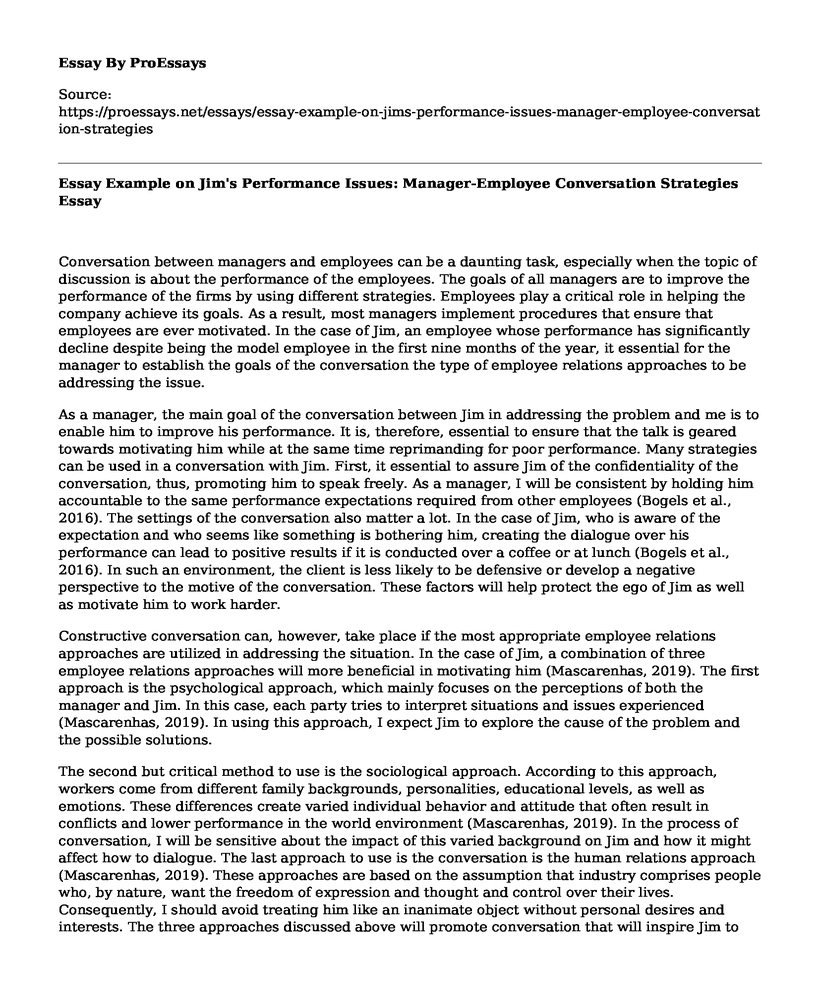Conversation between managers and employees can be a daunting task, especially when the topic of discussion is about the performance of the employees. The goals of all managers are to improve the performance of the firms by using different strategies. Employees play a critical role in helping the company achieve its goals. As a result, most managers implement procedures that ensure that employees are ever motivated. In the case of Jim, an employee whose performance has significantly decline despite being the model employee in the first nine months of the year, it essential for the manager to establish the goals of the conversation the type of employee relations approaches to be addressing the issue.
As a manager, the main goal of the conversation between Jim in addressing the problem and me is to enable him to improve his performance. It is, therefore, essential to ensure that the talk is geared towards motivating him while at the same time reprimanding for poor performance. Many strategies can be used in a conversation with Jim. First, it essential to assure Jim of the confidentiality of the conversation, thus, promoting him to speak freely. As a manager, I will be consistent by holding him accountable to the same performance expectations required from other employees (Bogels et al., 2016). The settings of the conversation also matter a lot. In the case of Jim, who is aware of the expectation and who seems like something is bothering him, creating the dialogue over his performance can lead to positive results if it is conducted over a coffee or at lunch (Bogels et al., 2016). In such an environment, the client is less likely to be defensive or develop a negative perspective to the motive of the conversation. These factors will help protect the ego of Jim as well as motivate him to work harder.
Constructive conversation can, however, take place if the most appropriate employee relations approaches are utilized in addressing the situation. In the case of Jim, a combination of three employee relations approaches will more beneficial in motivating him (Mascarenhas, 2019). The first approach is the psychological approach, which mainly focuses on the perceptions of both the manager and Jim. In this case, each party tries to interpret situations and issues experienced (Mascarenhas, 2019). In using this approach, I expect Jim to explore the cause of the problem and the possible solutions.
The second but critical method to use is the sociological approach. According to this approach, workers come from different family backgrounds, personalities, educational levels, as well as emotions. These differences create varied individual behavior and attitude that often result in conflicts and lower performance in the world environment (Mascarenhas, 2019). In the process of conversation, I will be sensitive about the impact of this varied background on Jim and how it might affect how to dialogue. The last approach to use is the conversation is the human relations approach (Mascarenhas, 2019). These approaches are based on the assumption that industry comprises people who, by nature, want the freedom of expression and thought and control over their lives. Consequently, I should avoid treating him like an inanimate object without personal desires and interests. The three approaches discussed above will promote conversation that will inspire Jim to work hard.
From the above discussion, it is evident that conversation between managers and employees can be difficult, especially when it involves reprimanding an employee. Many strategies can be used to create constructive dialogue. Besides, it is vital to ensure that the appropriate employee relationship strategies are used. The most common effective employee relations strategies to be used in Jim's case are the combination of sociological, psychological, and human relations approaches.
References
Bogels, S., Casillas, M., & Levinson, S. C. (2016). To plan or to listen? The trade-off betweencomprehension and production in conversation. In the Eighth Annual Meeting of the Society for the Neurobiology of Language (SNL 2016). https://pure.mpg.de/pubman/faces/ViewItemOverviewPage.jsp?itemId=item_2310776
Mascarenhas, B. G. (2019). Employer branding, employee value proposition, and employeeexperience: new approaches for people management in organizations. In Strategic Employee Communication (pp. 97-103). Palgrave Macmillan, Cham. https://link.springer.com/chapter/10.1007/978-3-319-97894-9_8
Cite this page
Essay Example on Jim's Performance Issues: Manager-Employee Conversation Strategies. (2023, Apr 24). Retrieved from https://proessays.net/essays/essay-example-on-jims-performance-issues-manager-employee-conversation-strategies
If you are the original author of this essay and no longer wish to have it published on the ProEssays website, please click below to request its removal:
- Marla's Work Profile - Essay Sample
- Human Resources Manager Comprehensive Occupation Description
- Ethical Arguments About Marketing Essay Example
- Finger Worth $2 Billion Essay Example
- Paper Example on Kyle's Negligence Tort: Understanding the Law & Seeking Redress
- Essay on Ford Motors: A Bold New Vision for Leadership, Teamwork, and Negotiation
- Paper Example on Corporate Social Responsibility (CSR): Is It A Necessity?







